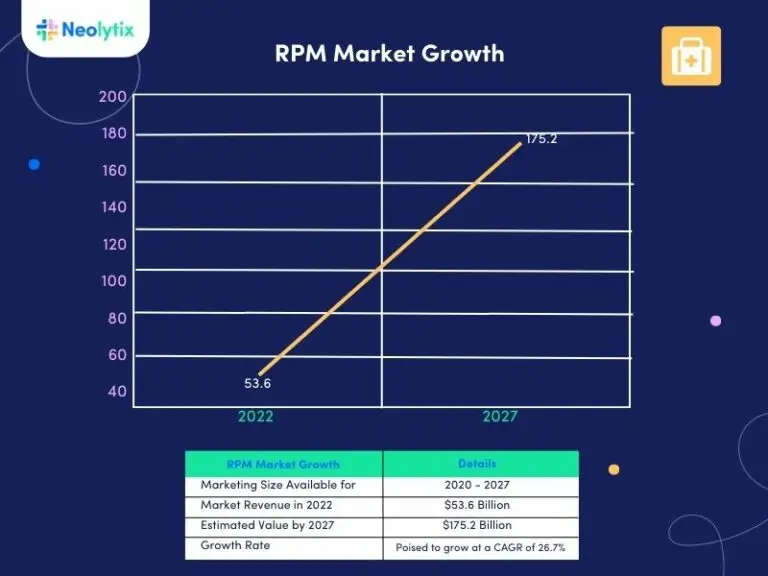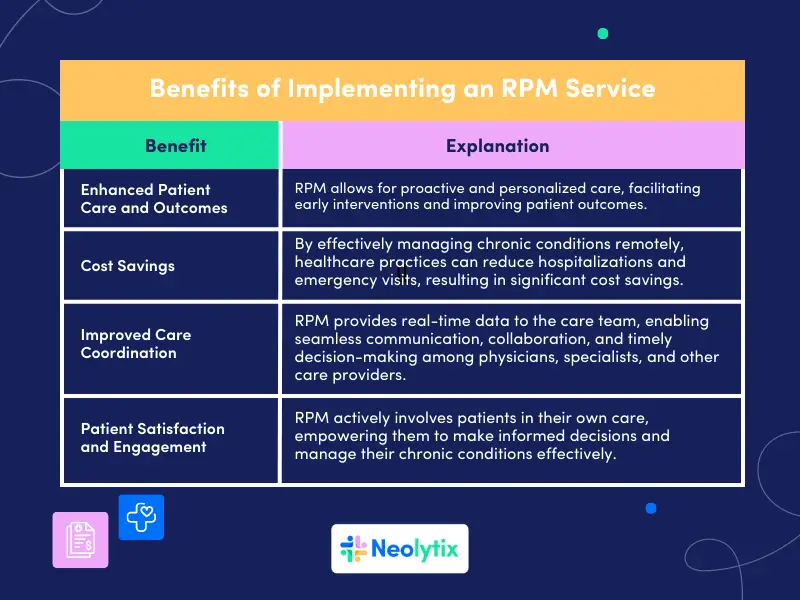Remote Patient Monitoring (RPM) allows healthcare providers to track patients’ vital signs and health data remotely. This tool enables proactive care and personalized adjustments to treatment plans, significantly impacting the ROI in healthcare.
RPM is beneficial for both patients and healthcare providers. It helps in managing chronic conditions and preventing potential health complications. This proactive care approach enhances patient outcomes and provides substantial remote patient monitoring cost savings.
This article discusses RPM and its future. It also covers the benefits of using an RPM service and the expected ROI in healthcare.
The Future of RPM

RPM’s future looks bright as healthcare moves towards value-based care and patient-centered models. Remote patient monitoring programs are becoming easier to use as technology improves and more devices connect. This benefits both patients and healthcare providers.
Patients find it easier to participate in their own care. Healthcare providers find it easier to monitor patients remotely. Integrating artificial intelligence and machine learning algorithms can enhance data analysis and predictive capabilities, enabling healthcare professionals to deliver even more personalized care.
As healthcare systems prioritize cost savings and improved patient satisfaction, the demand for RPM is expected to grow exponentially, further impacting the return on investment in healthcare information technology.
Benefits of Implementing an RPM Service
Implementing an RPM service offers several benefits for healthcare providers and their patients, such as improved patient engagement, better health outcomes, and significant remote patient monitoring cost savings.

The Expected ROI of RPM
Remote patient monitoring has positively impacted reducing hospitalizations, emergency visits, and healthcare costs. A study from 2017 in the Journal of Medical Internet Research examined multiple studies. It discovered that utilizing remote patient monitoring for chronic conditions has the potential to reduce costs.
In 2019, a study was published in the Journal of Medical Economics. The study showed that using remote patient monitoring for chronic heart failure patients had two benefits. The first benefit was saving money. The second benefit was improving patient outcomes.
Studies show that using remote patient monitoring can save money and make healthcare more efficient. The exact savings may vary, but overall, it is agreed that this technology is beneficial for healthcare organizations of all sizes, including small practices.
Book a free consultation with us to learn about the ROI of remote patient monitoring for your healthcare organization.
Calculating the ROI of RPM
Healthcare providers are looking at Remote Patient Monitoring (RPM) to improve patient care and increase revenue. It’s important to figure out the Return on Investment (ROI) of this new service. Knowing how RPM affects finances can help healthcare providers make better decisions and improve their health organization’s effectiveness. Here are key considerations to determine the ROI of RPM:
Cost Analysis
Begin by evaluating the costs associated with implementing and maintaining an RPM program. This includes initial investments in technology infrastructure, devices, software integration, staff training, and ongoing technical support. Carefully assess the upfront and recurring expenses to understand the financial implications comprehensively. Understanding the cost of remote patient monitoring is crucial for accurate ROI calculation.
Revenue Opportunities
Identify the potential revenue streams that can be generated through RPM. Medicare and other payers offer reimbursement for remote monitoring services when specific criteria are met. Familiarize yourself with the reimbursement codes and requirements for your healthcare organization and patient population.
Consider the eligible patients who can be enrolled in an RPM program and estimate the additional revenue generated.
Reduced Hospitalizations and Emergency Visits
One of the primary benefits of RPM is the potential to reduce hospitalizations and emergency visits. Analyze historical data and estimate the number of hospitalizations or emergency visits related to the target patient population. Calculate the cost of events and predict potential savings from monitoring and early interventions by RPM, highlighting the remote patient monitoring cost saving.
Improved Resource Utilization
RPM can optimize resource utilization within your healthcare organization. Assess the time and effort saved by reducing in-person visits for routine monitoring and follow-ups. Consider the potential increase in patient capacity due to the efficiency gained through RPM. Calculate the impact on physician time, nursing staff utilization, and overall workflow optimization, key aspects in medical office management ROI analysis.
Patient Satisfaction and Retention
Satisfied patients are more likely to continue seeking care from your healthcare organization. Analyze patient satisfaction scores, feedback, and retention rates for those enrolled in RPM programs. Happy and engaged patients are more likely to follow their treatment plans and refer others to your organization. This can lead to increased revenue over time.
Data Analysis and Monitoring Program Optimization
Leverage the insights derived from RPM data analysis to identify trends, gaps, and areas for improvement. Continuously refine and optimize the RPM program based on the data collected.
This process is essential for ROI solutions for healthcare organizations. Fine-tuning the program can lead to better patient outcomes, higher satisfaction, and increased revenue over time.
Investing in healthcare can bring financial benefits like higher revenue and happier patients. This can result in a positive return on investment. The actual ROI can differ based on the healthcare organization and the patients they serve and this also applies to the exact ROI.
Understanding the Full Spectrum of ROI
Remote Patient Monitoring (RPM) is a key component in modern healthcare strategies, offering numerous financial and operational benefits. To fully appreciate the potential of RPM, it’s crucial to understand various aspects of its ROI monitoring and how it fits into the broader healthcare landscape.
The ROI of Healthcare IT
Investing in healthcare IT, particularly RPM, can significantly enhance the return on investment in healthcare information technology. By streamlining patient data collection and analysis, RPM helps healthcare providers make informed decisions faster, improving patient outcomes and operational efficiency.
Medical Device ROI
RPM devices deliver substantial medical device ROI by reducing in-person visits and enabling continuous monitoring, cutting healthcare delivery costs, and enhancing patient satisfaction.
Remote Patient Monitoring ROI
Evaluating remote patient monitoring ROI involves assessing direct benefits like RPM cost savings from fewer hospital admissions and indirect benefits such as improved chronic disease management.
What is ROI in Healthcare?
What is ROI in healthcare? It measures financial gains from healthcare technology investments. Effective ROI assessment considers setup costs, maintenance, and financial benefits from improved patient care.
What is ROI in Medical Billing?
RPM influences ROI in medical billing by streamlining processes, ensuring accurate coding, and maximizing reimbursements, leading to a higher return on investment.
Calculating the RPM Cost and Growth
The remote patient monitoring cost includes initial investments in devices and training. However, the growth in RPM adoption is driven by the substantial cost savings and efficiency improvements it offers. Utilizing an RPM investment calculator can help healthcare organizations quantify these benefits and make informed decisions about their investment.
Return on Investment in Value-Based Care
RPM aligns perfectly with the goals of value-based care, which emphasizes patient outcomes over service volume. By facilitating continuous monitoring and early intervention, RPM can significantly enhance the return on investment in value-based care models.
By addressing these critical components, healthcare providers can make informed decisions about investing in RPM and fully realize the financial and operational benefits it offers.
Optimizing RPM Workflow
To maximize the benefits of RPM, it’s crucial to optimize RPM workflows. This involves integrating RPM seamlessly into existing healthcare processes, ensuring that the data collected is actionable and that staff are trained to use the technology effectively. Optimized workflows lead to better patient outcomes and higher financial returns.
RPM: A Win-Win for Patient Outcomes and Your Bottom Line
Investing in Remote Patient Monitoring (RPM) with Neolytix revolutionizes healthcare delivery by enhancing patient care, reducing costs, and optimizing resource utilization. Our 100% risk-free revenue model, Medicare-approved RPM devices, and no upfront investment make it easy for healthcare organizations to implement RPM seamlessly. Plus, we offer complimentary claims submission and billing, ensuring a hassle-free experience.
Choose Neolytix for your RPM needs and benefit from our expertise, scalability, and commitment to excellence. Contact us today for a free, no-obligation consultation to understand how our RPM solutions can transform your practice and maximize your ROI.
Frequently Ask Questions
Remote patient monitoring (RPM) can face challenges such as data security concerns, patient adherence to using devices, and the need for sufficient infrastructure to support continuous monitoring. Without proper training and technical support, healthcare staff may struggle with implementing RPM systems effectively. Additionally, some patients may find it difficult to adjust to the technology, which could limit the overall impact of the program.
Yes, Medicare does cover certain RPM services, provided specific criteria are met. Healthcare providers can bill Medicare for RPM under several reimbursement codes that apply to monitoring chronic conditions and ongoing management. Understanding these codes and ensuring accurate documentation are key to optimizing reimbursement.
Telemedicine, including RPM, is poised to become even more integral to healthcare as technology continues to advance. With improved accessibility, better devices, and integration with AI-driven tools, telemedicine is expected to offer more personalized care and support value-based care models. The future likely holds greater adoption across healthcare organizations, leading to enhanced patient experiences.
One of the main challenges of RPM is ensuring that patient data is secure and HIPAA-compliant, especially given the sensitive nature of health information. Other challenges include the initial costs of implementation, training staff, and encouraging patients to actively engage with the monitoring devices. Additionally, providers must ensure that they stay up to date with billing guidelines and reimbursement processes.
Stakeholders in RPM include healthcare providers, patients, payers (such as Medicare and private insurers), and technology providers. Healthcare administrators and policymakers also play a role, particularly in setting guidelines and reimbursement rates. Neolytix works closely with healthcare decision-makers to streamline RPM implementation, maximizing the benefits for all stakeholders involved.
The value of RPM lies in its ability to improve patient care while reducing healthcare costs. By allowing real-time monitoring of vital signs, RPM enables early detection of potential health issues, reducing hospital admissions and emergency room visits. These benefits make RPM a cost-effective and proactive approach to managing patient health, particularly for chronic conditions.
RPM significantly enhances health outcomes by facilitating continuous monitoring and enabling timely interventions. This proactive care model helps healthcare providers address issues before they become serious, leading to better disease management and improved patient well-being. Patients with chronic conditions, in particular, benefit from the ongoing oversight provided by RPM programs.
RPM provides cost savings by reducing the need for in-person visits, minimizing hospital readmissions, and preventing emergency room visits through early detection of health issues. Medicare and other payers also offer reimbursements for RPM services, further offsetting costs for healthcare providers. Neolytix helps healthcare organizations optimize these financial benefits through efficient RPM integration and management.
By automating the collection of patient data and reducing the frequency of in-person appointments, RPM optimizes resource use within healthcare organizations. Providers can focus on critical cases while monitoring other patients remotely, improving overall efficiency. This frees up time for physicians and staff, enabling them to manage a larger patient population more effectively.
RPM improves chronic disease management by offering continuous tracking of key health metrics, allowing healthcare providers to make timely adjustments to treatment plans. This helps patients better manage their conditions, reducing the risk of complications and hospitalizations. With Neolytix's support, healthcare organizations can efficiently implement RPM programs tailored to chronic care needs.
RPM supports post-surgical recovery by allowing healthcare providers to monitor patients remotely, ensuring that they are healing properly and detecting any early signs of complications. This enables providers to intervene quickly when necessary, reducing the likelihood of readmissions and speeding up recovery times. Patients can recover in the comfort of their homes, while still receiving regular care oversight.
RPM provides significant benefits to elderly and vulnerable populations by offering continuous monitoring of their health conditions without requiring frequent trips to healthcare facilities. This ensures early intervention for any emerging issues while providing peace of mind to patients and their families. Neolytix's RPM solutions are designed to help healthcare providers deliver personalized care to these sensitive populations.
RPM generates valuable data that healthcare providers can use to create and refine personalized care plans. By continuously monitoring patient metrics, providers can track progress and adjust treatments more effectively. This leads to improved patient outcomes, as care plans are based on real-time information, making them more responsive to each patient’s evolving needs.
RPM enhances communication between patients and providers by offering a consistent flow of health data. This allows providers to stay updated on a patient’s condition without the need for frequent in-person visits. Additionally, patients can receive quicker feedback, fostering a more connected and proactive healthcare relationship.
RPM empowers patients to take an active role in managing their health by providing them with easy-to-use tools that track their condition. This engagement improves adherence to treatment plans and increases patient satisfaction, as they feel more involved in their own care. Healthcare providers also benefit from more engaged patients who are likely to experience better outcomes, further boosting overall satisfaction.
Schedule a free consultation to learn more
Complete the form, and someone from our team will contact you!



